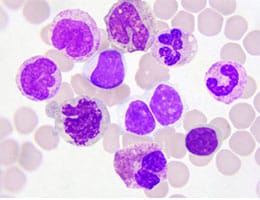 A monocyte is a leukocyte that has a single nucleus . Leukocytes or white blood cells , for their part, are lymph and blood cells that play a defensive role , moving through different areas of the body.
A monocyte is a leukocyte that has a single nucleus . Leukocytes or white blood cells , for their part, are lymph and blood cells that play a defensive role , moving through different areas of the body.
Monocytes are the largest leukocytes. Approximately two to ten percent of the white blood cells in the blood belong to this group of cells. In more graphic numbers, we can say that for every microliter of blood we find between 200 and 600 monocytes.
The monocyte nucleus is usually lobe or kidney shaped with a depression. This nucleus is surrounded by a large amount of bluish or grayish cytoplasm with white vacuoles.
The bone marrow is responsible for producing monocytes. Once released into the blood , they can reach multiple organs and tissues, such as bones, the lungs or the liver. Monocytes remain in the bloodstream for about a day and then access the connective tissue by crossing the endothelium of the capillaries.
The most important task carried out by monocytes is to phagocytose remains of cells or microorganisms. To do this, they surround them with their pseudopods and, if they notice that it is an antigen, they “eat” them.
Due to this function, monocytes are considered phagocytes . This is the name given to cells that take over elements that are useless or harmful to the body, incorporating them into their cytoplasm and finally digesting them. Thanks to their actions, monocytes achieve the stimulation of immune responses.
It is important to note that the life of monocytes is around three days. When they complete their work, they automatically die.
In summary, we can affirm that monocytes help us in an indispensable way in the fight against certain infections and that they collaborate with other leukocytes in the elimination of damaged or dead tissues, in the destruction of cancer cells and in the regulation of immunity against substances. strange
When monocytes leave the blood and enter the tissues, they transform into macrophages, the most important cells in the cleaning task of the immune system . Some genetic anomalies prevent the proper functioning of monocytes and macrophages, through the accumulation of lipids (fatty waste) within the structure of the cells. As a result, various diseases arise, including Niemann-Pick and Gaucher disease.
 An abnormal amount of monocytes, both lower and higher than expected, does not usually cause symptoms, although the patient may experience them due to the disease responsible for said alteration. To diagnose an autoimmune disease or infection, it is common to perform a blood test. Sometimes a low or high monocyte count is seen on this test even though it was not the initial goal.
An abnormal amount of monocytes, both lower and higher than expected, does not usually cause symptoms, although the patient may experience them due to the disease responsible for said alteration. To diagnose an autoimmune disease or infection, it is common to perform a blood test. Sometimes a low or high monocyte count is seen on this test even though it was not the initial goal.
Monocytosis is a disorder characterized by a higher than normal monocyte count. It usually occurs due to certain chronic infections, blood disorders, some types of cancer , or autoimmune diseases. An increase in the number of macrophages outside the blood, such as in the skin or lungs, is usually due to an infection such as Langerhans cell histiocytosis or sarcoidosis.
On the other hand, there is monocytopenia , an insufficient number of monocytes in the blood. It can occur as a result of various problems that affect the white blood cell count, such as chemotherapy treatment , bone marrow problems, or a blood infection.
The genetic disorder known as monoMAC syndrome affects the bone marrow and causes an especially low monocyte count, as well as reducing the number of some types of lymphocytes.
